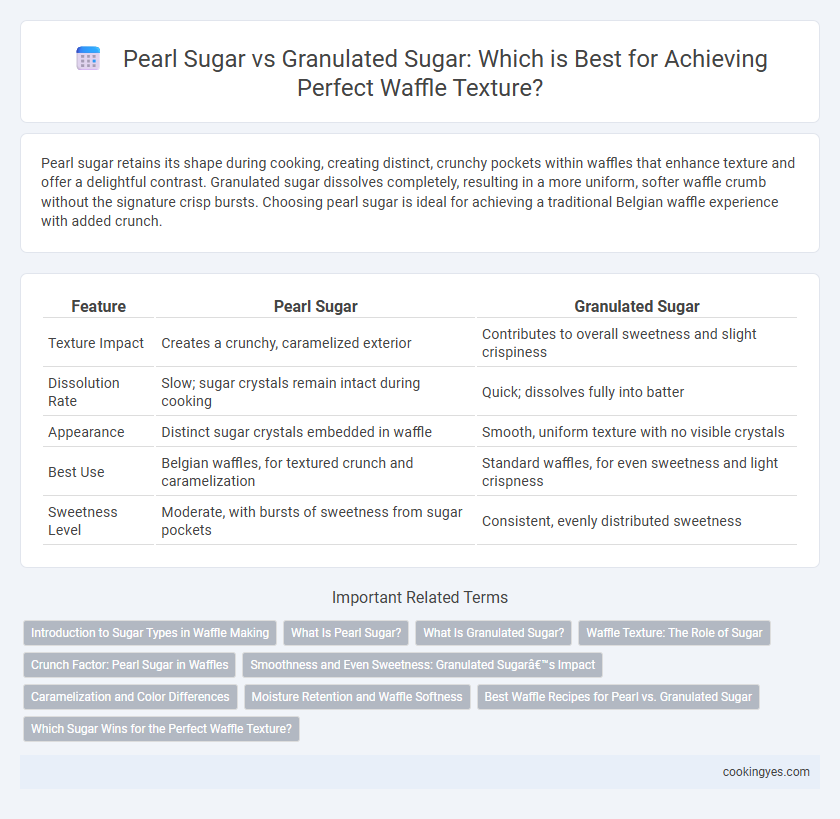Pearl sugar retains its shape during cooking, creating distinct, crunchy pockets within waffles that enhance texture and offer a delightful contrast. Granulated sugar dissolves completely, resulting in a more uniform, softer waffle crumb without the signature crisp bursts. Choosing pearl sugar is ideal for achieving a traditional Belgian waffle experience with added crunch.
Table of Comparison
| Feature | Pearl Sugar | Granulated Sugar |
|---|---|---|
| Texture Impact | Creates a crunchy, caramelized exterior | Contributes to overall sweetness and slight crispiness |
| Dissolution Rate | Slow; sugar crystals remain intact during cooking | Quick; dissolves fully into batter |
| Appearance | Distinct sugar crystals embedded in waffle | Smooth, uniform texture with no visible crystals |
| Best Use | Belgian waffles, for textured crunch and caramelization | Standard waffles, for even sweetness and light crispness |
| Sweetness Level | Moderate, with bursts of sweetness from sugar pockets | Consistent, evenly distributed sweetness |
Introduction to Sugar Types in Waffle Making
Pearl sugar and granulated sugar serve distinct roles in waffle making, directly influencing texture and crispiness. Pearl sugar, with its coarse, chunky crystals, creates pockets of caramelized sweetness and a characteristic crunch in Belgian waffles. Granulated sugar dissolves completely, contributing to even sweetness and a tender, soft crumb without added texture contrast.
What Is Pearl Sugar?
Pearl sugar is a type of coarse, white sugar composed of large, compact crystals that do not melt easily during cooking, making it ideal for creating a distinctive crunchy texture in waffles. Unlike granulated sugar, which dissolves completely and adds overall sweetness, pearl sugar retains its shape and provides pockets of caramelized sugar crunch within the waffle. This unique property of pearl sugar enhances the waffle's texture by offering a delightful contrast between the soft interior and crisp sugar bits.
What Is Granulated Sugar?
Granulated sugar consists of fine, uniformly sized white crystals commonly used in baking for its ability to dissolve quickly and sweeten batter evenly. In waffle recipes, granulated sugar contributes to caramelization and a slightly crisp exterior but lacks the moisture-retaining properties of pearl sugar. Unlike pearl sugar, granulated sugar blends seamlessly into the batter, resulting in a smoother texture without the distinctive crunchy pockets found in waffles made with pearl sugar.
Waffle Texture: The Role of Sugar
Pearl sugar creates a distinct, crunchy texture in waffles due to its large, coarse crystals that caramelize without fully dissolving, resulting in pockets of sweetness and a crisp bite. Granulated sugar, with its fine particles, dissolves completely in the batter, contributing to a uniform tenderness but lacking the characteristic crunch that pearl sugar imparts. Choosing pearl sugar enhances the waffle's texture through its unique caramelized bursts, while granulated sugar yields a smoother, softer crumb.
Crunch Factor: Pearl Sugar in Waffles
Pearl sugar enhances the crunch factor in waffles by creating caramelized pockets of sweetness that remain intact during cooking, unlike granulated sugar, which dissolves and disperses evenly. The large, coarse crystals of pearl sugar provide distinct, crispy bites that contrast with the soft waffle interior, elevating texture and flavor complexity. Using pearl sugar results in waffles with a signature crunchy exterior, preferred in traditional Belgian waffle recipes.
Smoothness and Even Sweetness: Granulated Sugar’s Impact
Granulated sugar dissolves more evenly in waffle batter, contributing to a smooth texture and consistent sweetness throughout each bite. Unlike pearl sugar, which remains coarse and creates crunchy pockets, granulated sugar integrates fully, preventing uneven sweetness or gritty spots. This uniform dissolution enhances the overall mouthfeel, delivering a soft, tender waffle with balanced flavor.
Caramelization and Color Differences
Pearl sugar creates distinct caramelized pockets in waffles due to its large, coarse crystals that melt slowly, enhancing both texture and flavor with a subtle crunch. Granulated sugar dissolves more quickly, leading to uniform sweetness but less pronounced caramelization and a paler waffle color. The slower melting point of pearl sugar results in deeper browning and richer caramel tones, crucial for traditional Belgian-style waffles.
Moisture Retention and Waffle Softness
Pearl sugar contributes to superior moisture retention in waffles due to its coarse, dense structure, which melts slowly and creates pockets of caramelized sweetness without drawing out moisture. Granulated sugar, being finer, dissolves quickly and can lead to a drier texture by drawing out moisture during baking. Using pearl sugar enhances waffle softness and a tender crumb by maintaining internal moisture, resulting in a more enjoyable mouthfeel.
Best Waffle Recipes for Pearl vs. Granulated Sugar
Pearl sugar creates a distinctively crisp and crunchy texture in waffles by caramelizing on the surface without dissolving, ideal for authentic Belgian-style recipes. Granulated sugar dissolves completely, resulting in a softer, more uniform batter with a tender crumb, preferred for traditional American waffles. Choosing between pearl and granulated sugar depends on the desired waffle texture, where pearl sugar enhances crunch and granulated sugar provides a smooth, even consistency.
Which Sugar Wins for the Perfect Waffle Texture?
Pearl sugar creates a unique, crispy texture with caramelized pockets in waffles, offering a delightful crunch that granulated sugar cannot achieve. Granulated sugar dissolves completely during cooking, resulting in a softer, more uniform waffle crumb without the signature crisp bites. For the perfect waffle texture, pearl sugar wins by delivering a satisfying contrast of crunchy exterior and tender interior.
Pearl sugar vs granulated sugar for waffle texture Infographic

 cookingyes.com
cookingyes.com